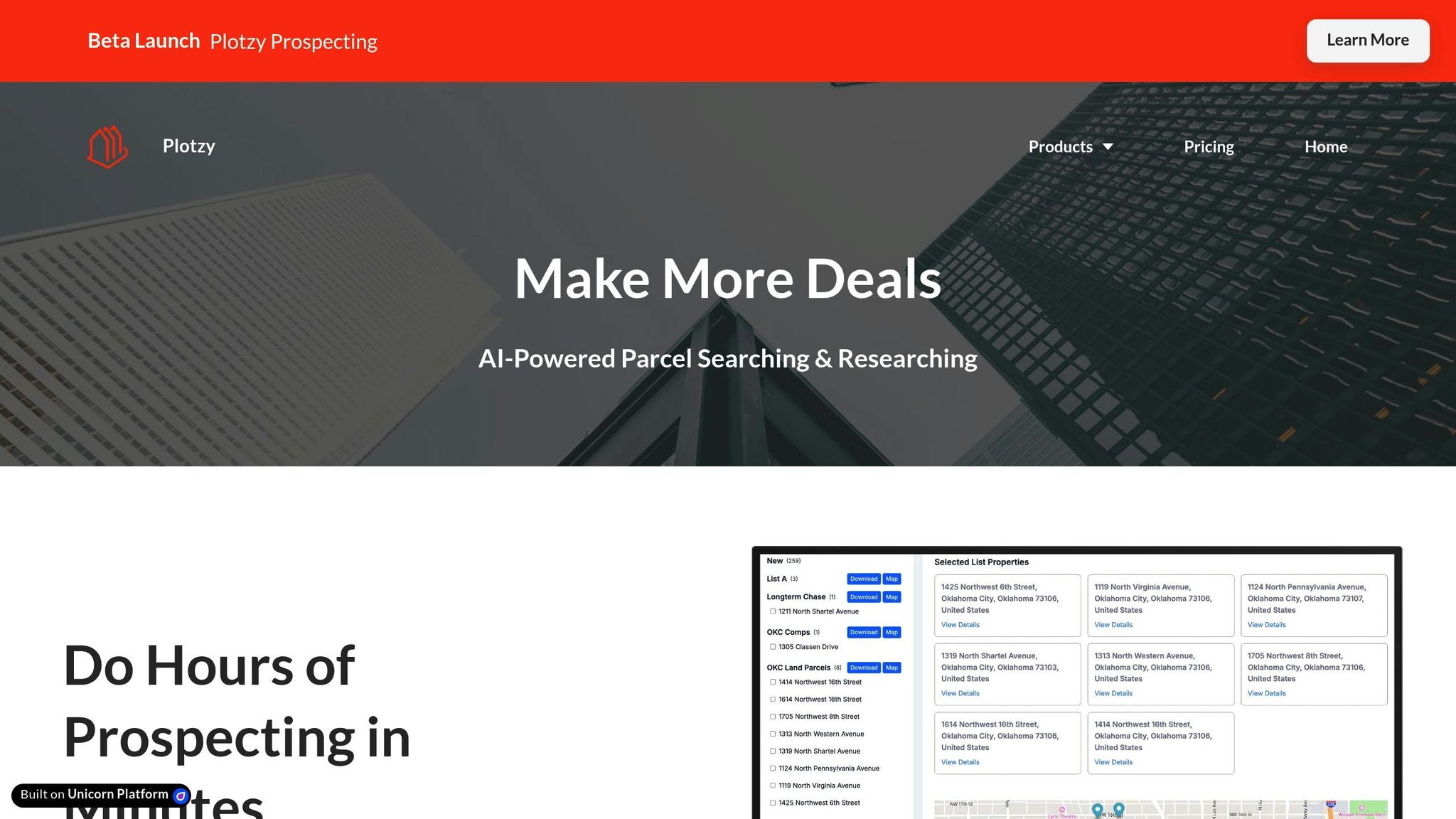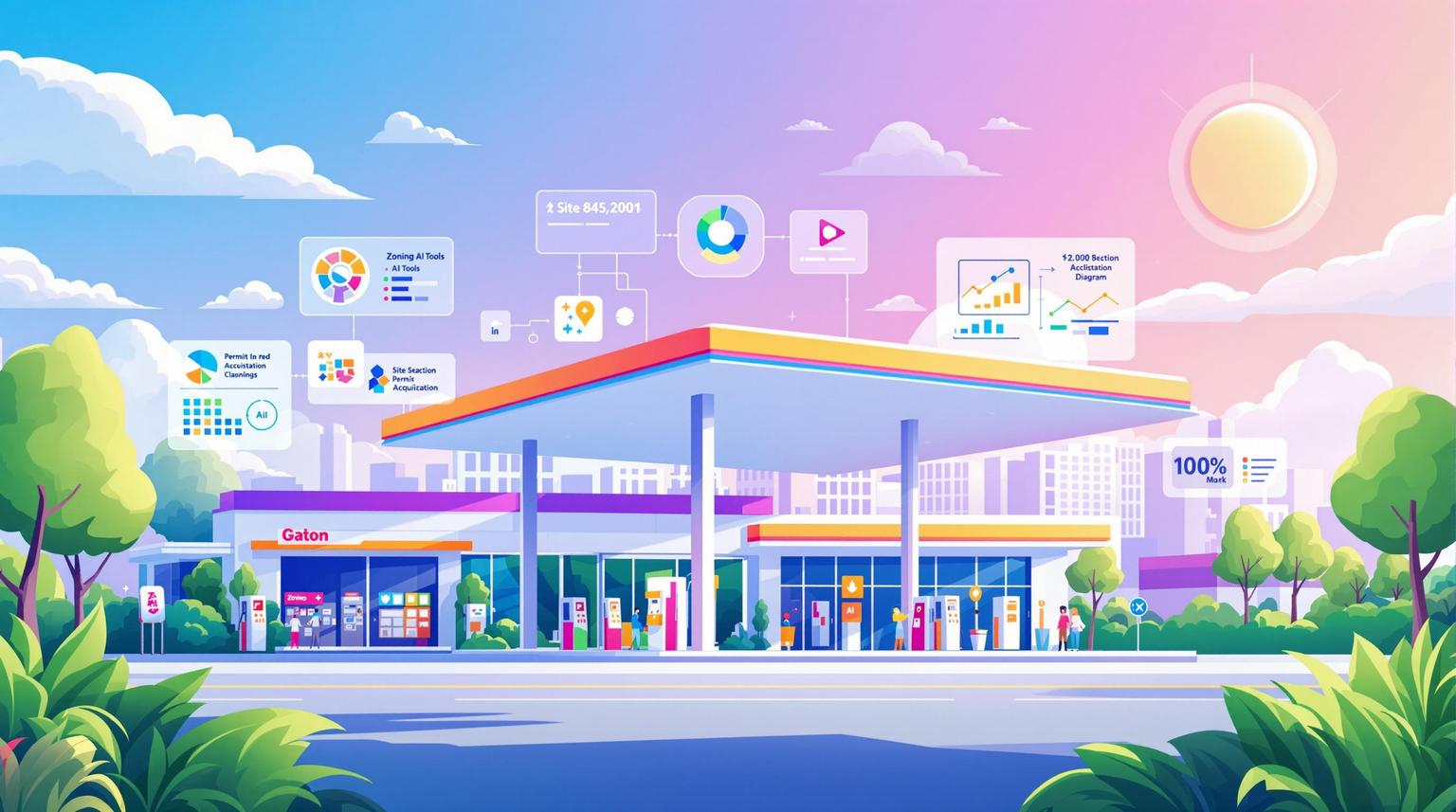Zoning in Colorado defines how land can be used - whether for homes, businesses, farming, or mixed purposes. Here’s what you need to know:
- Zoning Categories: Residential, Commercial, Industrial, Agricultural, and Mixed-Use.
- Local Control: Cities and counties create zoning rules and maps. Overlay zones may add extra restrictions, like historic preservation.
- Key Details: Zoning codes dictate building heights, setbacks, parking, and permitted uses.
- AI Tools: Platforms like Plotzy speed up zoning research, helping you find properties, analyze zoning, and access municipal codes.
Quick Tips:
- Use local GIS portals to find zoning maps.
- Check zoning codes for specific restrictions.
- Consider AI tools to save time and simplify research.
Zoning impacts everything from property use to development potential. Dive into your local rules to make informed decisions.
Colorado Zoning Types
Main Zoning Categories
In Colorado, land is divided into five primary zoning types: residential, commercial, industrial, agricultural, and mixed-use. Here's a quick breakdown:
- Residential zones: Designed for housing developments.
- Commercial zones: Reserved for retail stores, offices, and other business-related activities.
- Industrial zones: Focused on manufacturing and warehousing operations.
- Agricultural zones: Protect farmland and may restrict non-agricultural developments.
- Mixed-use zones: Combine residential, commercial, and sometimes industrial uses within one area.
These categories set the foundation for how land is used and pave the way for more specific zoning types.
Commercial Zone Types
Commercial zones are further divided into categories like C-1, C-2, and C-3. These classifications help distinguish smaller neighborhood retail areas from larger community or regional developments. Each district comes with its own rules regarding permitted uses, building heights, setbacks, parking requirements, and buffers. These guidelines are crucial for brokers and investors when assessing whether a site fits their needs.
In addition to these basic commercial zones, municipalities often use overlays and mixed-use districts to tailor land use for specific areas.
Special Zones and Districts
Overlay zones add extra regulations on top of existing zoning to address specific priorities, such as preserving historic landmarks, protecting natural resources, or meeting design standards. Meanwhile, mixed-use districts combine residential, commercial, and sometimes industrial spaces under a unified framework. These districts focus on creating walkable areas by balancing building heights, setbacks, compatible uses, and pedestrian-friendly designs.
Finding Zoning Information
Local Zoning Authority
Zoning rules in Colorado are primarily set by individual cities and counties. Each has its own ordinances and zoning maps tailored to local needs. For instance, the City and County of Denver operates under its own zoning code, designed to align with local development goals. The Colorado Department of Local Affairs provides resources like template codes and guidelines to help counties and municipalities shape their regulations. To start, locate the zoning maps and records relevant to your area.
Zoning Maps and Records
To conduct accurate zoning research, you need reliable data sources:
- Municipal Websites: Many city and county websites have GIS portals. For example, Denver’s GIS portal allows users to search by parcel and view zoning designations.
- National Zoning Atlas: The 2025 Atlas provides a standardized overview of zoning details across the Denver metro area.
Reading Zoning Codes
When reviewing zoning codes, pay attention to key details like:
- Permitted land uses
- Building height restrictions
- Setback and density requirements
- Parking rules
- Applicable impact fees
- Procedures for public hearings
For specific questions about a property, contact the local planning department. If changes to zoning are needed, you may need to apply for a variance or rezoning, which often involves public hearings and approval from a zoning board.
Understanding Zoning Regulations in Colorado - with an ...
sbb-itb-11d231f
AI Tools for Zoning Research
Once zoning maps and codes are located, brokers can speed up their research by leveraging AI tools.
AI in Property Research
AI platforms simplify the process of navigating zoning codes by analyzing municipal and assessor data. This can save between 30 and 60 minutes per search by quickly identifying relevant parcels.
Plotzy Features

Plotzy offers several tools designed to streamline zoning research:
- Parcel Search: Filter properties by zoning, current use, and permitted use to find suitable sites.
- Zoning Analysis: Use an AI-powered Q&A feature with source links for better understanding of regulations.
- Owner Contact Info: Automatically pull property owner details from public records for outreach.
- Property Reports: Combine county assessor data to aid decision-making.
- Municipal Resources: Access zoning codes, maps, and fee information all in one place.
These features are designed to integrate seamlessly with workflows for site selection, zoning verification, and outreach.
The Basic Plan is priced at $65/month and includes 200 owner contact matches, parcel filtering, instant zoning answers, and access to municipal resources. The Pro Plan, at $200/month, increases to 1,000 owner contact matches and adds support for custom shapefiles.
Using Plotzy
Professionals rely on Plotzy's AI tools to handle key tasks like:
- Site Selection Research: Filter searches based on zoning designations and permitted uses to create a shortlist of potential properties.
- Zoning Verification: Get immediate answers to zoning questions, complete with links to municipal codes or zoning maps.
- Property List Management: Organize and compare potential sites on interactive maps, making it easier to evaluate opportunities across different areas.
"Plotzy's AI can perform research tasks, such as finding property owners' contact information", says Nathan Robinson, Co‑Founder & CEO of Plotzy.
Solving Zoning Problems
Plotzy's AI workflows can help tackle common zoning challenges head-on.
Major Zoning Issues
Commercial real estate developers in Colorado often face several zoning challenges:
- Variance Requests: Developers may need exceptions to zoning rules, like height limits or setback requirements. To succeed, they must demonstrate that strict adherence to the rules creates undue hardship.
- Rezoning Applications: Urban growth often leads to requests for zoning changes. These applications can spark debates, as developers must prove the new use serves the public's interest.
- Mixed-Use Compliance: Mixed-use projects - blending residential, commercial, and retail spaces - require a clear understanding of rules around allowable uses and density.
- Overlay Zone Restrictions: Overlay zones add extra regulations, such as historic preservation or environmental standards, which can impact design, materials, and site planning.
Problem-Solving Methods
Here are some strategies for navigating these zoning hurdles:
- Pre-Development Research: Use AI tools to analyze zoning regulations, density limits, and site constraints before acquiring property. This can save time and reduce risks.
- Legal and Community Support: Work with a local real estate attorney and involve community stakeholders early in the process. This can help secure backing for variances or rezoning efforts.
With Plotzy's AI, developers can streamline zoning analysis, minimize research time, and focus on strategic decision-making.
Summary
Here's a quick rundown to help guide your next steps:
Key Insights
- About 77% of Denver's land is zoned for single-unit residential use, highlighting the importance of a thorough zoning analysis.
- While local governments control zoning policies, state-level actions are increasingly shaping housing affordability and growth strategies.
Research Tools
Plotzy's AI-based platform simplifies zoning research in Colorado's commercial real estate market. It helps you:
- Assess permitted uses, density limits, and site restrictions
- Create detailed property reports and view zoning maps
- Filter parcels by zoning criteria to find the best opportunities
Next Steps
- Dive into municipal codes and overlay districts for your chosen site.
- Focus on mixed-use zones and areas with strong development potential.
- Stay informed about changes in state and local zoning policies, especially those tied to affordable housing.
- Connect with local zoning authorities early to identify potential challenges and necessary approvals.


